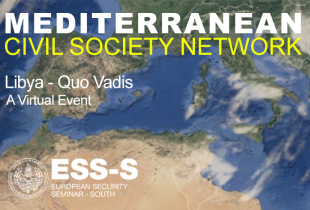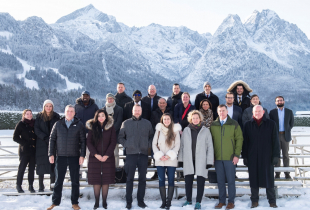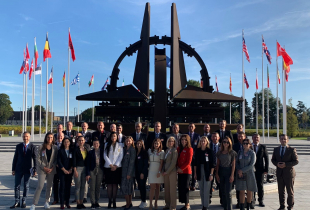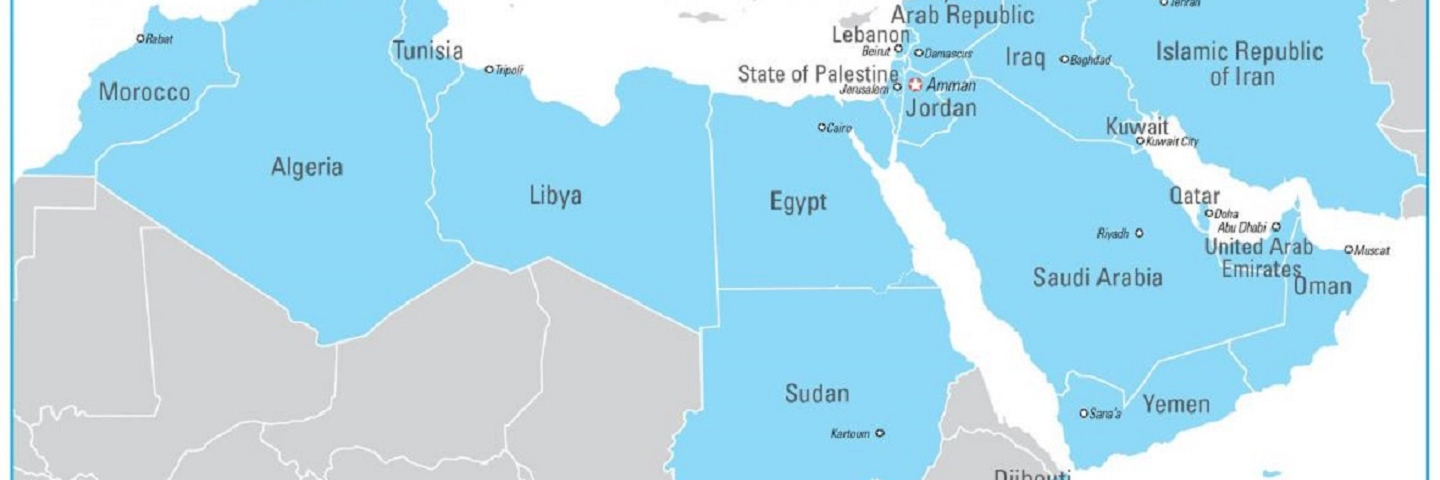
Demographic Change and Youth in the Middle East and North Africa (MENA) Region: Issues of Human or National Security
Executive Summary
Between 19–23 March 2018, the George C. Marshall European Center for Security Studies, a German-American partnership, brought together sixty-four military and civilian midlevel to senior security policy practitioners and experts from thirty-four countries from Europe, the Middle East and North Africa (MENA), Sub-Saharan Africa, Australia, and the United States in order to collaborate on our third European Security Seminar South (ESS-S). The group’s tasks were to explore how best to respond to the security challenges resulting from demographic change and the youth bulge in the MENA region and to build a common understanding of the new dynamics on Europe’s southern flank. Participants were divided into five working groups, which all addressed the same issues.
The working group sessions were designed to generate four outputs. First, the groups discussed whether the demographic change in the region was a problem of human security or rather of national security as well as what implications this issue had for the MENA region and for Europe. Second, the goals and means of current programs focusing on the region were assessed, again considering program goals by the dimensions of human or national security. Third, based on the previous assessment of the current situation, participants discussed and made predictions about what the status of human and national security in the region would be if current programs were to be continued in the same manner and with the same policy goals. Lastly, participants gave policy recommendations pertaining to useful adjustments to strategy that should be considered while dealing with the issue at hand. This issue of Security Insights is the result of these deliberations.
What’s at Stake?
Demographic change in the MENA region is often referred to either as a ticking time bomb or an opportunity to harvest the demographic dividend. The challenge, it thus seems, is to identify the risks associated with a rapidly changing demographic environment and the influence this has on regional economies, labor markets, societies, and political systems. Eventually, European security could also be in jeopardy due to phenomena like migration, radicalization, and terrorism.
The Demographic Challenge
The MENA countries are currently in a state of demographic transition.1 Shrinking fertility rates compared to previous decades have resulted in a youth bulge, so the determinable demographic trend is proceeding towards a gradually aging society. Nevertheless, there is still an increase in the region’s absolute population figures that is expected to reach a population of about one billion people by 2090, surpassing even China and nearly doubling Europe’s population numbers by the end of the century.2 At the same time, while the majority of MENA countries are abundant in labor, they are poor in resources, which exacerbates the challenge of establishing sufficiently diversified economies that are conducive to sustainable development.
Unemployment of the younger generations across MENA as a result of the youth bulge is an additional challenge.3
This has wide-ranging effects on the constitution of these societies, with both hugely positive and potentially disastrous outcomes regarding the stability and security environment on Europe’s southern border. In addition to increasing pressure on state facilities and social security systems as a result of the higher population, the most prominent problem will be the labor market. With populations growing faster than the availability of jobs, higher rates of unemployment seem to be unavoidable. Surprisingly, highly-educated people are more likely to remain outside the workforce because educational systems are not properly aligned with labor markets. These changes increase the region’s vulnerability to crises of all kinds. Long periods of unemployment in the younger demographic lead to dissatisfaction and potential social unrest initiated by the better interconnected, capable youth, therefore jeopardizing political stability in the region and its neighbors.4
In previous decades, better educated individuals mostly found job opportunities working for their governments, however with an already inflated public sector and an increase in the young and educated populace, this safety net cannot be sustained any longer. Moreover, the Gulf states’ demand for foreign labor from MENA countries such as Egypt or Algeria has diminished greatly due to declining oil prices and the reallocation of resources to military expenditures.The negative effects of the demographic change can be disproportionally felt by countries with already low political stability, such as Algeria, Libya, Iraq, or Yemen, further fueling existing social and economic unrest.
A different perspective on the problem puts this young and increasingly educated population at the forefront of solving contemporary economic and social problems.5 If the Gulf states succeed in adequately integrating this demographic into their national economies, these young people can contribute their qualifications to their societies, leading to a more diverse, multi-layered private sector that can provide wealth to a greater number of people. Historically, greater wealth can be linked to an increase in state legitimacy. Countries like South Korea and Singapore, for example, have successfully undergone this transition, harvesting the demographic dividend and transforming themselves into viable and stable states.
Europe at Risk?
These scenarios offer multiple implications for Europe. Europe’s economies could greatly benefit from an economically strengthened and stable southern neighborhood. The youth bulge could turn out to be a blessing for Europe’s shortages in qualified labor. Enhancing the positive impact, guest workers often return to their home states, equipped with more knowledge and experience, and therefore better able to contribute to the development of the MENA region.
More directly, healthy MENA economies could create a new outlet for goods and services from Europe and eventually make MENA countries major trading partners, adding to the potential benefits of a positive outcome for both sides.
On the other hand, however, if these demographic challenges remain unaddressed, this could spell disaster for the national security of European countries. The perception that there is no potential for a good future, in addition to rising regional social pressures, especially within the younger and more mobile population, could lead to increased streams of migrants entering the European continent and potentially cause higher susceptibility to political and religious extremism. The latter could eventually manifest itself in terrorist attacks.
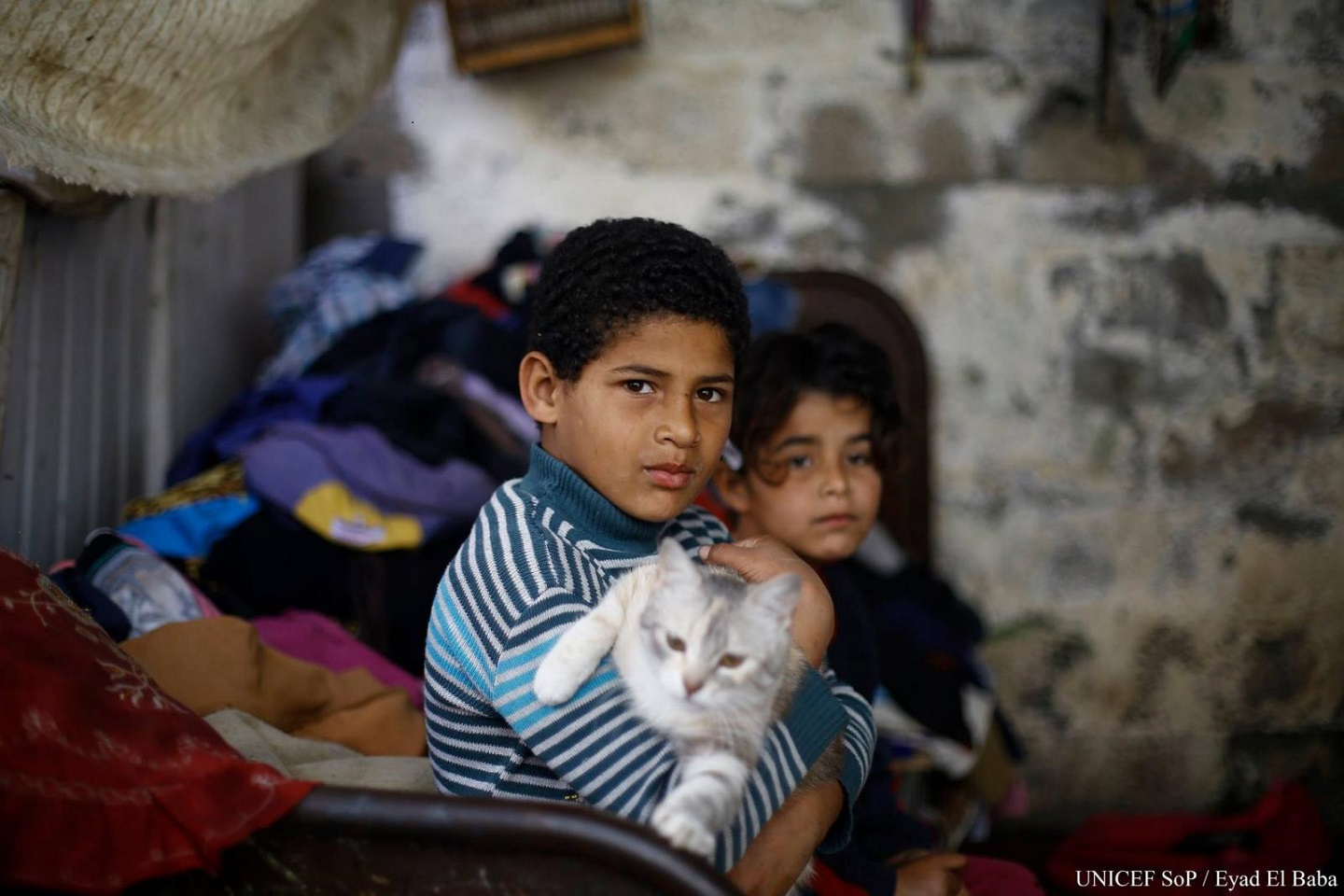
The Issue of Securitization: Human Security vs. National Security
The issue at hand has historically been seen as a national security problem and has therefore inspired countermeasures from the field’s corresponding agencies. Through a process commonly referred to as “securitization,” the efforts to deal with demographic change and the problems arising from it have primarily been focused on national security.6 When an issue is “securitized,” an actor or actors—in this case, mostly western states—will often frame the problem as an urgent threat and demand extraordinary countermeasures, sometimes including measures that are not normally in the realm of the democratic process. The issue is, therefore, whether on purpose or inadvertently, dramatized and raised to an issue of high priority. The more dramatized an issue, the more likely it is to be acted against through a national security approach, such as border security, military training, anti-terrorism missions, and counter migration initiatives.7 The question remains whether this approach, which has so far been utilized by most of Europe and North America, can be efficient at dealing with more than just symptoms, especially considering the structural changes inherent in the root cause: demographic change.
With increasing securitization of a problem, budgetary developments inevitably ensue, as well. For instance, the U.S. State Department’s 2018 budget request outlines a drop to $16.8 billion in bilateral economic assistance compared to $25.3 billion in 2017.8 Adding to that, there a disparity in foreign assistance already exists in the MENA region. Over 70 percent of foreign assistance in 2016—$9.6 billion dollars—was labeled as military assistance either handled by the Department of Defense or the Army. This is compared to a global share of U.S. foreign assistance spending of approximately 31 percent, which is being assigned to military expenditures.9
European engagement in the region is currently more diverse. The European Neighborhood Policy (ENP) is the common framework that the EU uses to address issues in its direct surroundings. Through the ENP, the EU provides support to sixteen neighboring countries, spending more than €15 billion from 2014-2020.10 Between €7.5 and €9.2 billion are allocated for the Southern Neighbourhood, €824 million of which are directly assigned to the Regional South Programme, in order to promote democracy, rule of law, respect for human rights, and social cohesion.11 Additionally, human security is addressed through a wide range of programs focusing on everything from education to employment measures and empowerment of women. In this regard, European coordination can still be improved, with member states currently handling most of the program planning and implementation themselves. Apart from that, national security-related measures include border security missions in Libya and Palestine, as well as a training mission in Mali, and a coordinated effort to combat migrant smuggling and trafficking in the Mediterranean through Operation SOPHIA.12
A revision of the current approaches is therefore needed, one which requires placing human security issues at the forefront of the discussion to effectively prevent the spread of the human security issue of demographic change in the MENA region into the national security sphere.
Donor Coordination and Recipient Ownership
But it is not just the budgetary allocation that is responsible for such an insufficient approach to date Coordination efforts by donor countries often fall victim to separate state agendas. Strategies need to be aligned and programs need to be integrated if they are to fight more than just the symptoms of ongoing crises and societal changes. Due to electoral pressure at home, policy makers in European countries naturally tend to prefer short-term solutions. A long-term vision is desperately needed, however, if one wishes to align donor countries’ policy goals and instruments.
Recipient ownership, the flip side of donor coordination, also comes into play. Collaboration with local governments is often challenged by the delicate but necessary issue of conditionality. The goal of democratic reform needs to be addressed carefully, while remaining constantly engaged so as to be able to exert pressure and affect or even change local governing structures. There is, however, a great opportunity to improve upon development programs and their sustainability if regional governments can be involved in the implementation process and become stakeholders of the programs themselves. Despite many common features, such as Arabic as a shared language, comparatively little regional integration and policy coordination on joint demographic and economic policies have been developed thus far.
An Integrated Approach
At this point, it should be clear that an integrated approach addressing both national and human security is needed. So far, the strategies with which both areas have been addressed differ greatly from one another. While national security measures often include capacity building, this key aspect is less present in the human security sphere. Capacity building needs to be part of the solution to promote more sustainable measures. Eventually, in the best case scenario, essential services like education and food or water security can be provided by the local governments themselves rather than international development actors. At the same time, national security policies should further incorporate “conditionality” in order to promote lasting stability and lay the necessary groundwork for human security programs to also be effective.
As mentioned, the challenges in the region are already difficult to overcome, but with the rapidly growing population, the situation in the MENA region seems likely to significantly worsen. A vicious circle has established itself in the MENA region, one in which state instability leads to lower investment due to the risk for foreign investors. As a result, many states in the region face difficulties establishing a functioning private sector, which in turn leads to rising unemployment rates and insecurity, especially for the youth. This insecurity then has a large impact on the stability of the states, which completes the circle. To fight this, it is important to establish a regional and integrated approach.
To provide such a regional approach, it is important to take regional expertise into account and work to strengthen cohesion across the region.13 At the moment, there is a lack of coordination regarding the current assistance plans and programs, so the establishment of international forums to initiate and coordinate all of the assistance would be a big step forward. Another way to improve cooperation and oversight could be to make already existing supranational or international organizations, such as the EU, responsible for coordinating donor policies.
Promising Partnerships?
Partnerships with regional actors already exist. One example of multilateral engagement is the NATO Mediterranean Dialogue, a partnership that brings together NATO and seven non-NATO countries from the Mediterranean region.14 It emphasizes the close linkage between security and stability in the region and is very clearly focused on further cooperation in the military field. Unfortunately, by mainly focusing on just the national security side of the issue, it doesn’t provide the integrated approach that is needed to deal with the issue at hand.
Another example of interregional cooperation can be found in the Organization for Security and Co-operation in Europe’s (OSCE) Mediterranean Partners for Co-operation. Through it, the OSCE maintains special relationships with six partners in the region, sharing insights and expertise and enhancing existing interrelationships in areas such as security and stability, migration and integration, economic and environmental issues as well as the human dimension.15
One Partnership that could be helpful in solving the problems related to European and MENA countries is the Union for the Mediterranean (UfM).16 The Union was founded in 2008 as a result of the Barcelona Process and the European Neighborhood Policy. All twenty-eight EU countries as well as fifteen non-EU Mediterranean countries are members of this organization. Since 2013, the UfM has initiated and coordinated more than fifty projects designed to improve the political and economic situation in its member states, especially in the Mediterranean area.17
The UfM stated clearly that there can be no development without security and no security without development, showing the great interdependencies between human and national security. One of the main aims of the UfM is to provide regional solutions for regional challenges through a common approach to problems, especially in the MENA region. The UfM can be seen as a political forum where ideas and approaches to problems can be discussed, as a platform to promote regional dialogue, and also as a coordinating body for projects with regional inputs.
These projects are divided into two main components, Regional Sustainable Development and Regional Human Development.
The Regional Sustainable Development component addresses areas that need to be improved in order to fulfill people’s primary needs (e.g. food and water security, infrastructure, and energy supply). Forty-four percent of the UfM’s total engagement is focused on this effort, while fifty- six percent of the programs target human development topics. The Regional Human Development sphere includes support for education and research training programs and social and civil affairs, as well as creating and facilitating the establishment of a functioning private sector labor market, which is key for tackling the growing unemployment rates in the region.
Therefore, the UfM provides a particularly good example of an implementations strategy that effectively establishes the nexus between security and development.
Conclusion and Recommendations
The most viable strategy to address the challenges emanating from the demographic change in the MENA region is a transregional approach, which consists of national security measures to keep the region relatively stable as well as human security measures to increase the likelihood of the MENA states to be able to provide sustained government services to the constituencies in the future without foreign aid. There are a few important areas such a strategy must target, such as the provision of food security, water security, infrastructure, and energy supply, all of which are primary needs. Another area that must be improved is the labor market, which is currently suffering from a large discrepancy between the needs of the labor market and the education of the youth in this region. To reverse this trend, an improvement in private sector development is necessary, along with the adjustment of education systems so that they meet the demands of the private sector. This issue is interconnected with the problem of foreign investment, which is relatively low due to the insecurity in the region. This vicious circle needs to be overcome, because as was previously mentioned, security and development only work in cooperation with one another.
Of course, effective policies need to address both the human security and national security aspects of the problem. The following recommendations were agreed upon during the seminar as a means to improve upon both of these areas:
- Empower youth in the region by establishing regional networks that focus on economic and political participation.
- Regional cooperation among the security actors must be improved, in addition to consultation with regional security actors and further facilitation of capacity building.
- Another important improvement is the implementation of conditional elements within the current national security programs that rewards progress. On the other hand, even in the face of disagreeing policies, diplomatic contacts should not be abandoned.
- Investment in rule of law institutions should be enhanced to improve upon accountability of government leaders in the region.
- Delicate issues like gender and religion should be carefully targeted. To achieve this, it is important to create communication platforms between religious, youth, and government leaders in order to align their aims and strategies for each country individually, taking into account regional differences in culture.
- Capacity building needs to play a bigger role in the realm of human security so as to enable long lasting and sustainable improvement.
- Educational cooperation needs to be enhanced, with the intention of deepening cultural interaction and understanding between vastly different societies.
- Technology transfer can potentially play a big role in encouraging private sector Capacity building and individual security efforts for issues like food and water security should not be mutually exclusive, but rather integrated into a broader, results-oriented framework.
- Divert focus in national security from resilience building to sustainability investment.
For Academic Citation
Ralf Roloff et al., “Demographic Change and Youth in the Middle East and North Africa (MENA) Region: Issues of Human or National Security,” Marshall Center Security Insight, no. 23, August 2018, https://www.marshallcenter.org/en/publications/security-insights/demographic-change-and-youth-middle-east-and-north-africa-mena-region-issues-human-or-national.
Notes
1 “Arab Human Development Report 2016: Enabling Youth to Shape Their Own Future Key to Progress on Development and Stability in Arab region UNDP, November 29, 2016, accessed June 2, 2018, http://www.undp.org/content/undp/en/home/presscenter/pressreleases/2016/11/29/arab-human-development-report.
2 “World Population Prospects: The 2017 Revision,” UNDESA/United Nations Department of Economic and Social Affairs, accessed 2017, https://www.un.org/development/desa/publications/world-population-prospects-the-2017-revision.html.
3 More on this can be found in: Musa McKee, Martin Keulertz, Negar Habibi, Mark Mulligan, and Eckart Woertz, “Demographic and Economic Material Factors in the MENA Region,” no. 3, October 2017, accessed June 2, 2018, http://www.menaraproject.eu/wp-content/uploads/2017/10/menara_wp_3.pdf.
4 Akram Alfy, “Rethinking the Youth Bulge and Violence,” Institute of Development Studies, Vol. 47, no. 3 (May 26, 2016): 99-116, accessed June 2, 2018, http://bulletin.ids.ac.uk/idsbo/article/view/2732.
5 UNDP, Arab Human Development Report 2016, New York 2016; WNAA Institute, From Politics to Policy Building Regional Resilience in West Asia and North Africa, Amman 2017.
6 Barry Buzan Ole Waever, amd Jaap der Wilde, Security: A New Framework for Analysis (London: Lynne Rienner Publishers, Inc., 1998) 23-26.
7 Barry Buzan et al., Security, 35-42.
8 United States Department of State (2019), Congressional Budget Justification: Department of State, Foreign Operations, and Related Programs, Fiscal Year 2019, accessed June 2, 2018, https://www.state.gov/documents/organization/277155.pdf. (https://www.state.gov/plans-performance-budget/international-affairs-budgets/fy-2019-international-affairs-budget/).
9 USAID/United States Agency for International Development (2018), Foreign Aid explorer, accessed June 2, 2018, https://explorer.usaid.gov.
10 EEAS/European External Action Service (2016), European Neighbourhood Policy (ENP), https://eeas.europa.eu/headquarters/headquarters-homepage/330/european-neighbourhood-policy-enp_en.
11 “European Neighbourhood Policy And Enlargement Negotiations: Southern Neighborhood,” accessed June 2, 2018, https://ec.europa.eu/neighbourhood-enlargement/neighbourhood/southern-neighbourhood_en.
12 “Operation SOPHIA” EUNAVFOR MED, accessed May 29, 2018, https://www.operationsophia.eu/about-us.
13 Valentina Caracci and Ralf Roloff, “Crisis Response and Crisis Prevention on Europe’s Southern Flank: Challenges and Opportunities,” Marshall Center Security Insights, no. 20 (July 2017).
14 “NATO Mediterranean Dialogue,” North Atlantic Treaty Organization, accessed May 30, 2018, https://www.nato.int/cps/en/natohq/topics_60021.htm.
15 “Mediterranean Partners for Cooperation,” Organization for Security and Co-operation in Europe, accessed May 30, 2018, https://www.osce.org/partners-for-cooperation/mediterranean.
16 “Union for the Mediterranean,” accessed June 2, 2018, http://ufmsecretariat.org.
17 “Union for the Mediterranean: Projects and Initiatives with Regional Impact,” accessed May 30, 2018, http://ufmsecretariat.org/what-we-do/projects.
About the Authors
Professor Ralf Roloff is the Deputy Dean at the Marshall Center and Director of the ESS-S.
Nicolas Fulghum is a student of Political Science at Heidelberg University. He interned at the Marshall Center from February to April, 2018.
Henrik Simon is a student of International Cultural and Business Studies at the University of Passau. He interned at the Marshall Center from February to April, 2018.
Nicolas Reising is a student of Political Science at the University of Regensburg. He interned at the Marshall Center from February to April, 2018.
The co-authors would like to acknowledge the stimulating insights and observations offered by our ESS-S speakers, participants, working group leaders, the leadership team, and rapporteurs.
The Marshall Center Security Insights
The George C. Marshall European Center for Security Studies in Garmisch-Partenkirchen, Germany, a German-American partnership, is committed to creating and enhancing worldwide networks to address global and regional security challenges. The Marshall Center offers fifteen resident programs designed to promote peaceful, whole of government approaches to address today’s most pressing security challenges. Since its creation in 1992, the Marshall Center’s alumni network has grown to include over 13,715 professionals from 155 countries. More information on the Marshall Center can be found online at www.marshallcenter.org.
The articles in the Security Insights series reflect the views of the authors and are not necessarily the official policy of the United States, Germany, or any other governments.
